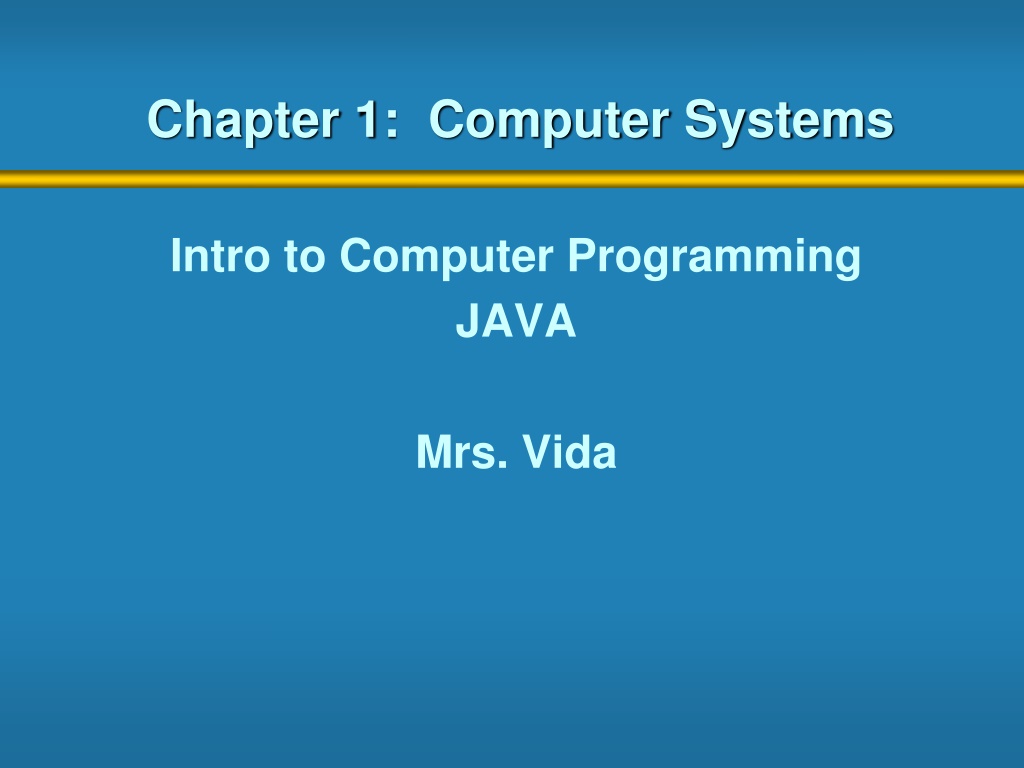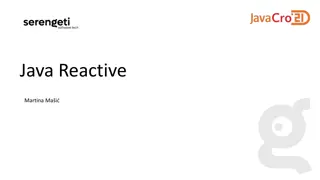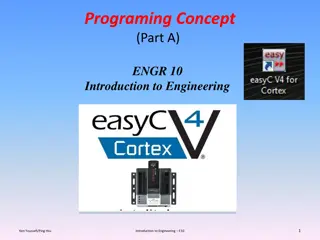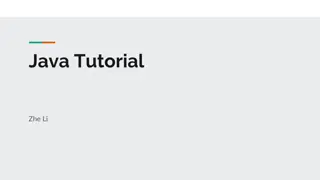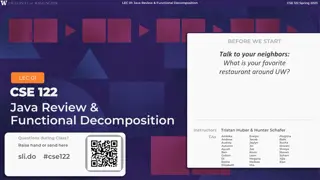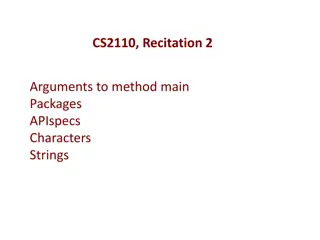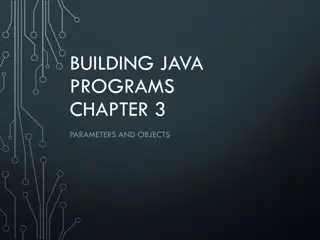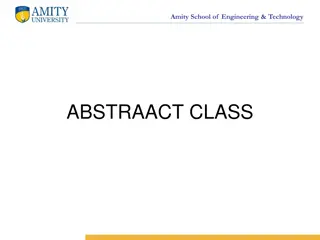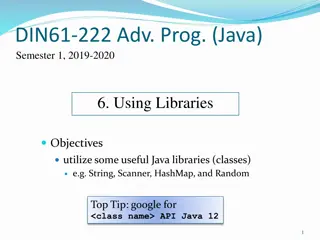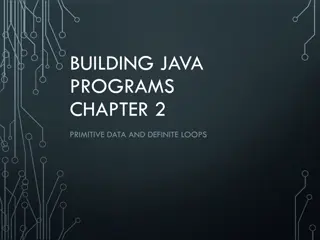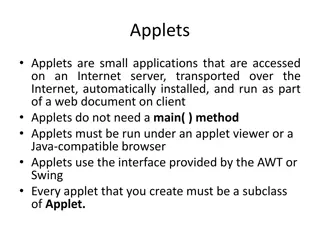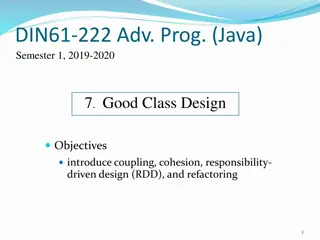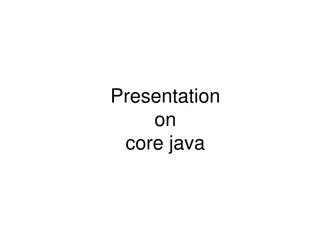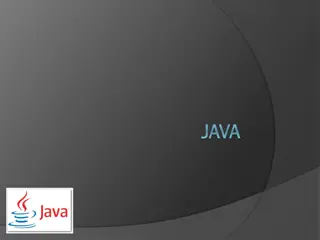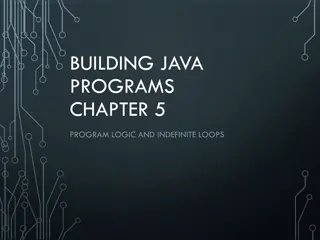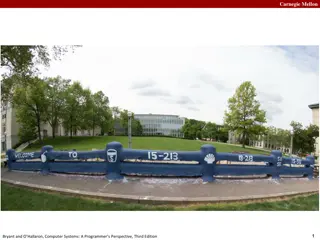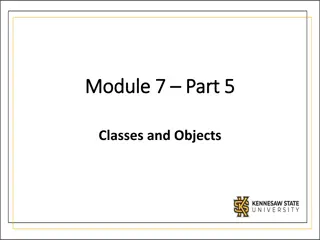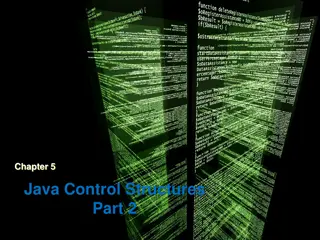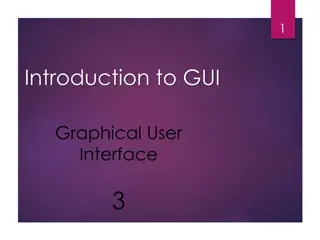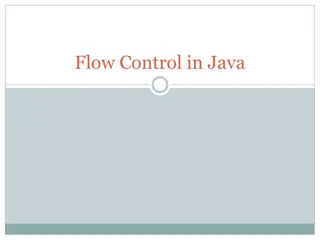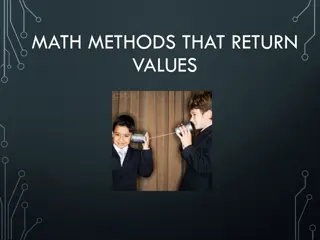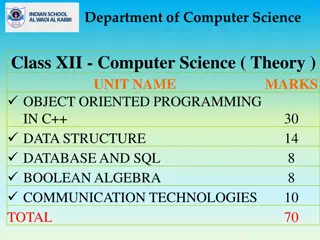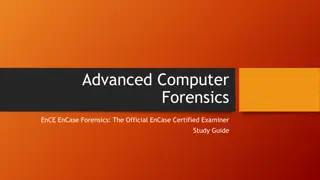Understanding Computer Systems and Programming Basics with JAVA
Introduction to computer systems, hardware, software, and different components like CPU, main memory, secondary memory devices, input/output devices, operating systems, and analog vs. digital data. Exploring the essential elements required for computer programming with examples and visuals.
Download Presentation

Please find below an Image/Link to download the presentation.
The content on the website is provided AS IS for your information and personal use only. It may not be sold, licensed, or shared on other websites without obtaining consent from the author. Download presentation by click this link. If you encounter any issues during the download, it is possible that the publisher has removed the file from their server.
E N D
Presentation Transcript
Chapter 1: Computer Systems Intro to Computer Programming JAVA Mrs. Vida
1.0 Hardware and Software Hardware the physical, tangible parts of a computer keyboard, monitor, disks, wires, chips, etc. Software programs and data a program is a series of instructions A computer requires both hardware and software Each is essentially useless without the other 2
1.0 Hardware Components CPU & Main Memory Chip that executes program commands Central Processing Unit Primary storage area for programs and data that are in active use Main Memory Synonymous with RAM 3
1.0 Hardware Components Secondard Memory Devices Information is moved between main memory and secondary memory as needed Secondary memory devices provide long-term storage Central Processing Unit Hard disks USB drives Writable CDs Tapes Hard Disk Main Memory Flash Drive 4
1.0 Hardware Components Input / Output Devices Monitor I/O devices facilitate user interaction Central Processing Unit Keyboard Monitor screen Keyboard Mouse Joystick Bar code scanner Touch screen Hard Disk Main Memory CD 5
1.0 Software Categories Operating System controls all machine activities provides the user interface to the computer manages resources such as the CPU and memory Examples: Vista, Windows XP, Unix, Linux, Mac OS Application program any other kind of software other than an O.S. word processors, missile control systems, games Most operating systems and application programs have a graphical user interface (GUI) Exampes: windows, icons, pull-down menus, scroll bars, buttons 6
1.0 Analog vs. Digital There are two basic ways to store and manage data: Analog Information is continuous Examples: music on a record album, thermometer Digital the information is broken down into pieces, and each piece is represented separately Example: music on a compact disc 7
1.0 Digital Information Computers store all information digitally: numbers text graphics and images video audio program instructions In some way, all information is digitized - broken down into pieces and represented as numbers 8
1.0 Representing Text Digitally For example, every character is stored as a number, including spaces, digits, and punctuation Corresponding upper and lower case letters are separate characters H i , H e a t h e r . 72 105 44 32 72 101 97 116 104 101 114 46 9
1.0 Binary Numbers Once information is digitized, it is represented and stored in memory using the binary number system A single binary digit (0 or 1) is called a bit A single bit can represent two possible states, like a light bulb that is either on (1) or off (0) 10
1.0 Bit Permutations 1 bit 0 1 2 bits 00 01 10 11 3 bits 000 001 010 011 100 101 110 111 4 bits 0000 0001 0010 0011 0100 0101 0110 0111 1000 1001 1010 1011 1100 1101 1110 1111 Each additional bit doubles the number of outcomes 11
1.1 Storage Capacity Every memory device has a storage capacity, indicating the number of bytes it can hold Capacities are expressed in various units: Unit Symbol Number of Bytes byte kilobyte megabyte gigabyte terabyte 20 = 1 210 = 1024 220 (over 1 million) 230 (over 1 billion) 240 (over 1 trillion) KB MB GB TB 12
1.1 Memory Main memory is volatile - stored information is lost if the electric power is removed Secondary memory devices are nonvolatile Main memory and disks are direct access devices - information can be reached directly The terms direct access and random access are often used interchangeably. 13
1.1 RAM vs. ROM RAM - Random Access Memory (direct access) ROM - Read-Only Memory The terms RAM and main memory are basically interchangeable ROM could be a set of memory chips, or a separate device, such as a CD ROM ROM chips embedded in main circuit board to provide instructions needed when computer is turned on. Both RAM and ROM are random (direct) access devices! RAM probably should be called Read-Write Memory 14
1.1 The Central Processing Unit A CPU is on a chip called a microprocessor It continuously follows the fetch-decode-execute cycle: Retrieve an instruction from main memory fetch execute decode Carry out the instruction Determine what the instruction is 15
1.1 The Central Processing Unit The CPU contains: Performs calculations and makes decisions Arithmetic / Logic Unit Coordinates processing steps Control Unit Small storage areas Registers 16
1.1 The Central Processing Unit The speed of a CPU is controlled by the system clock The rate at which the pulses occur is called clock speed. Speed of system clock tells you about how fast the CPU executes instruction. The speed is measured in megahertz (MHz) and gigahertz (GHz) 17
1.1 Monitor The size of a monitor (19") is measured diagonally, like a television screen A monitor has a certain maximum resolution , indicating the number of picture elements, called pixels, that it can display (such as 1280 by 1024) High resolution (more pixels) produces sharper pictures 18
1.1 Modem Data transfer devices allow information to be sent and received between computers 19
HOMEWORK Chapter 1 Multiple Choice 1.1, 1.4, 1.5 Short Answer 1.2 and 1.3 20
1.2 Networks A network is two or more computers that are connected so that data and resources can be shared Each computer has its own network address, which uniquely identifies it among the others A file server is a network computer dedicated to storing programs and data that are shared among network users 21
1.2 Network Connections Each computer in a network could be directly connected to every other computer in the network These are called point-to-point connections Adding a computer requires a new communication line for each computer already in the network This technique is not practical for more than a few close machines 22
1.2 Network Connections Most networks share a single communication line Adding a new computer to the network is relatively easy Network traffic must take turns using the line, which introduces delays Often information is broken down in parts, called packets, which are sent to the receiving machine and then reassembled 23
1.2 Local-Area Networks A Local-Area Network (LAN) covers a small distance and a small number of computers LAN A LAN often connects the machines in a single room or building 24
1.2 Wide-Area Networks A Wide-Area Network (WAN) connects two or more LANs, often over long distances LAN A LAN usually is owned by one organization, but a WAN often connects groups in different countries LAN 25
1.2 Metropolitan-Area Networks A Metropolitan-Area Network (MAN) connects two or more LANs, over distances less than 30 miles LAN LAN 26
1.2 The Internet The Internet is a WAN which spans the entire planet The word Internet comes from the term internetworking, which implies communication among networks It started as a United States government project, sponsored by the Advanced Research Projects Agency (ARPA) - originally it was called the ARPANET 27
1.2 IP and Internet Addresses Each computer on the Internet has a unique IP address, such as: 204.192.116.2 Most computers also have a unique Internet name, which also is referred to as an Internet address: spencer.villanova.edu The first part indicates a particular computer (spencer) The rest is the domain name, indicating the organization (villanova.edu) 28
1.2 Domain Names The last part of each domain name, called a top-level domain (TLD) indicates the type of organization: - educational institution - commercial entity - non-profit organization - network-based organization edu com org net Sometimes the suffix indicates the country: - United Kingdom - Australia - Canada - Sweden uk au ca se 29
1.2 The World Wide Web The World Wide Web allows many different types of information to be accessed using a common interface A browser is a program which accesses and presents information text, graphics, video, sound, audio, executable programs A Web document usually contains links to other Web documents, creating a hypermedia environment The term Web comes from the fact that information is not organized in a linear fashion 30
1.2 The World Wide Web Web documents are often defined using the HyperText Markup Language (HTML) Information on the Web is found using a Uniform Resource Locator (URL): http://www.lycos.com http://www.nhvweb.net/nhhs/math/cvida/ http://www.villanova.edu/webinfo/domains.html A URL indicates a protocol (http), a domain (www.villanova.edu), and possibly specific documents 31
HOMEWORK Multiple Choice p. 49: 1.2, 1.3 True/False p. 50: 1.2 1.4 Short Answer p. 51: 1.4 1.6 32
